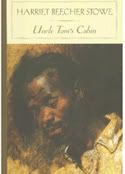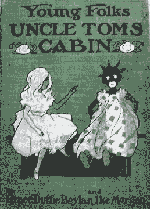UNCLE TOM’S CABIN by Harriet Beecher Stowe: Book Review
 Last week marked the 160th anniversary of the publication of Uncle Tom’s Cabin
Last week marked the 160th anniversary of the publication of Uncle Tom’s Cabin by Harriet Beecher Stowe in novel form. This seems like an appropriate time to give you my thoughts on the book (which I read in January.) And will you think me an utter barbarian to mark this anniversary by saying that I didn’t think Uncle Tom’s Cabin
was a great book?
Nearly everyone is familiar with most, if not all, of the plot and the characters of this classic. The main character Tom, a slave, is sold by his current owner, Kentucky famer Arthur Shelby, to pay debts. He is bought by Augustine St. Clair of New Orleans, a benevolent man who recognizes the evil in slavery but is not willing to relinquish the wealth it brings him.
Tom befriends St. Claire’s almost-too-good-to-be-true young daughter Eva, who dies, causing her father to determine to free his slaves. Before he follows through on this, he’s killed in a bar altercation.  Mrs. St. Clair reneges on her late husband’s promise and sells the household slaves to a trader. Tom ends up with Simon Legree. Legree is a tyrant who eventually has Tom whipped to death because he stood up to Legree and refused to stop practicing the Christianity he was taught at the Shelbys’.
Mrs. St. Clair reneges on her late husband’s promise and sells the household slaves to a trader. Tom ends up with Simon Legree. Legree is a tyrant who eventually has Tom whipped to death because he stood up to Legree and refused to stop practicing the Christianity he was taught at the Shelbys’.
There is also a subplot involving Eliza, a fellow slave of Tom’s. who overhears the plan to sell Tom & her son Harry and makes an escape to Canada.
Harriet Beecher Stowe was a puritanical Christian and an active abolitionist, and Uncle Tom’s Cabin reflects her values. The main theme of the book is an anti-slavery message. Stowe felt that “the most dreadful part of slavery (…) is the outrages of feelings and affections—separating of families, for example”, and she portrayed slavery as evil and immoral and as fundamentally incompatible with Christian theology.
That theology provides the secondary theme for the novel. It is this ancillary subject that gives Uncle Tom’s Cabin a “preachy” feel. At times, Stowe changes the voice of the story to be able to insert sermons on the saving nature of Christianity, and the evils of slavery. I’m not opposed to either message but the preaching irritated me at times. Especially did her Christians Tom and Eva have their heads in the clouds—and both received ‘visions’ before they died. That aspect was overly melodramatic for my taste.
Therein lies the biggest problem. This book is written in the style of a nineteenth-century sentimental novel. These types of books are characterized by wordiness (extreme at times) and outrages of feeling, both traits ever present in Stowe’s masterpiece. In fact, some critics have gone so far as to say that, if it had not been for the anti-slavery theme, Uncle Tom’s Cabin would have been just another sentimental women’s-lit novel of its day.
 A second problem with this novel is, of course, the stereotypes it helped to popularize – the loving, all-knowing mammy or the pickaninny image of black children, set by Topsy. Stowe makes such sweeping generalizations as “cooking (is) an indigenous talent of the African race”, “the negro is naturally more impressible to religious sentiment than the white”, and “they are a race that children will cling to and assimilate with”. Uncle Tom himself had been criticized for his long-suffering devotion to his white master, and accused of “selling out” to whites. To be fair, and in fact, it’s a different master-slave relationship that drives Tom to suffer stoically as he does—that of his master Jesus Christ.
A second problem with this novel is, of course, the stereotypes it helped to popularize – the loving, all-knowing mammy or the pickaninny image of black children, set by Topsy. Stowe makes such sweeping generalizations as “cooking (is) an indigenous talent of the African race”, “the negro is naturally more impressible to religious sentiment than the white”, and “they are a race that children will cling to and assimilate with”. Uncle Tom himself had been criticized for his long-suffering devotion to his white master, and accused of “selling out” to whites. To be fair, and in fact, it’s a different master-slave relationship that drives Tom to suffer stoically as he does—that of his master Jesus Christ.
Uncle Tom’s Cabin was the top selling novel in the US in the entire nineteenth century. It was second only to the Bible in total sales. A book read by hundreds of thousands, and that spawned plays seen by millions most certainly affected the overall thought of society, for good or for bad.
Whether Lincoln did or did not actually say to the author “so you are the little woman who wrote the book that started this great war”, it’s clear Stowe’s novel strongly influenced American society. It deserves to be read for that reason, if for no other.
This satisfies a whole passel of reading challenges including What’s In a Name, Classics with a Twist, Southern Literature, eBooks Reading Challenge, New Authors and Mammoth Book, as well as some alphabetical type challenges.
For my Canadian readers:
Uncle Tom’s Cabin
Kindle edition:
Uncle Tom’s Cabin FREE


You’re absolutely right about the overwrought drama and preachiness of this book, but it suited the times. I don’t believe the Lincoln legend for a minute. However, I do believe the book played a huge part in changing people’s attitude about slavery. “Uncle Tom” is still a slang presence in black people’s lives as a description of black men who don’t stand up to white people. Despite Stowe’s book, though, there was a remains a lot of prejudice in the north.
If Northerners bought into the stereotypes presented in the popular entertainment of the day based on the book, all the while considering themselves ‘enlightened’, it’s no wonder there was still prejudice, Barbara. As to it remaining – prejudice of any kind should not exist anywhere, but a novel won’t change that, unfortunately.